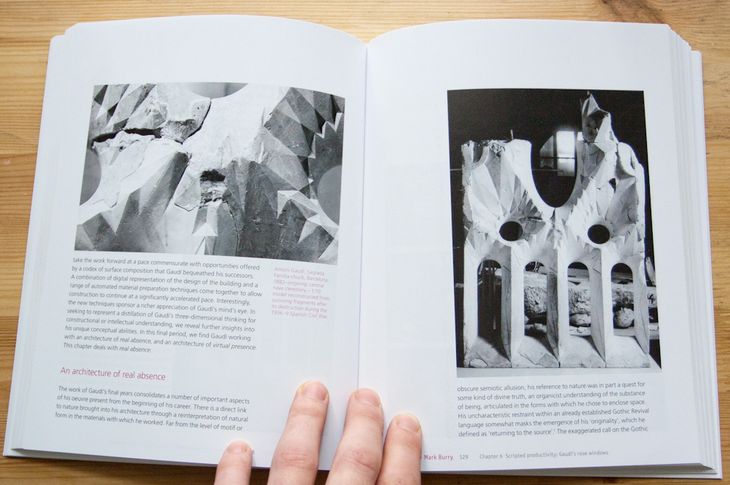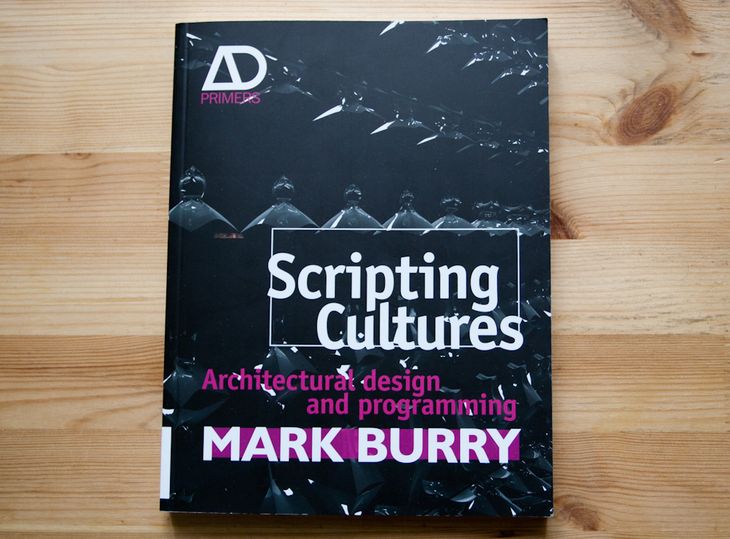This review of Mark Burry's Scripting Cultures (On Amazon
Scripting Cultures investigates why designers choose to script. Burry suggests two motivations: productivity and control. The evidence for these claims consists of a biographical account of Burry's own work, intermixed with a set of 'thought experiments,' and a set of interviews with thirty of the industries leaders (including: Casey Reas [Processing], Robert Aish [Generative Components + Designscript], John Frazer [An Evolutionary architecture], Axel Kilian, Neil Leach, Denis Shelden [Gehry] and Hugh Whitehead [Fosters]).
On the surface, productivity and control seem like utilitarian motivations to script, especially when compared to the writing normally associated with scripting: chest thumping proclamations of new paradigms footnoted with references towards incomprehensible continental philosophy. In place of these typical grandiose proclamations is a very honest assessment of how scripting can be applied to the design process. Burry admits that despite being introduced to scripting in a class taught by William Mitchell in the 1970's, he had no interest in scripting until he needed it for part of the design of the Sagrada Família in 1989. And even after picking up scripting Burry says he still finds it difficult and time consuming - as do all of the other 30 scripting wizards he interviewed. Burry's openness about the scripting process is not a dry utilitarian argument (despite appearances) but rather a refreshingly frank account of how scripting can augment the design process.

Burry sees the designer as central to the design process. His definition of design – the "mapping of an idea through to an intended outcome" – focuses on the designers aspiration rather than fetishising algorithmic effects. As such Burry views scripting as a conduit to enhance the design process, whether it is using productivity to iterate faster, or whether it is using the control of scripting to break free from the confines of black-boxed drafting software. The second half of the book focuses on a number of case studies where this happens. The case studies are characteristically honest about the challenges they faced and design method employed. I personally preferred the first half of the book to the case studies, but that might be because I am familiar with the case studies - I imagine someone who has not scripted before could find it insightful to see the nuts-and-bolts application of scripting in practice.
The book concludes by arguing for scripting as "an essential component of 21st-century design education." In doing so Burry cautions against classifying scripting as a single culture that could be seen as an "exclusivist force." Instead Burry affirms the importance of the designer in the scripting process, suggesting scripting is at home with the many cultures of design practice.

From my non-objective point of view, Scripting Cultures seems to articulate a maturing in our understanding of digital practice. It move the discussion away from self-congratulatory ego-shots demonstrating how clever we could be with scripts, and towards a time when scripting becomes a part of the everyday culture of design. For beginners I imagine this un-embellished description of scripting could offer some useful pathways into understanding the history, culture and role of scripting in design. For experienced scripters it is reassuring to hear 30 experts tell you they find it difficult as well. My major gripe with the book is that it only comes in physical form. For a book that so fully celebrates the capacity of technology to contribute to culture, waiting for it to be printed and mailed to you seems a little perverse. This is made even more stranger by the fact that Wiley - the publisher - is relatively progressive in making AD the journal available online. Yet for Scripting Cultures not even the contents is online (I put it below) and equally strangely there is a website where you can download some of the scripts from the case studies http://www.wiley.com/WileyCDA/Section/id-611118.html but it was not mentioned in the book. However, medium aside, Scripting Cultures makes an important contribution to the culture of scripting.
Somehow I have managed to end up with two copies of Scripting Cultures. If you would like my extra copy (its hardback) enter your name and email below. On the 17th of November I will randomly select someone to send it to. If you don't win you can always pick it up on Amazon and leave a comment on this post. Good luck!
18 November 2011: The winner of the competition was Harri Lewis, a post-graduate student at the University of Bath and blogger at HarriLewis.com
Chapters:
- Scripting cultures
- Contextural summary of computing, scripting and speculative design
- Cultural defence
- Resources
- Dimensions
- Scripted productivity: Gaudi's rose windows
- Composition and form
- Simplifying complexity for fabrication
- Scripting narrative space: Our world and The Third Policeman
- Performative scripting
- Cultural account: Scripting and shifts in authorship
- Glossary
- Scripting tools
- Recommended reading

Evgeny Shirinyan
Hi Daniel, This book became some sort of clue to rethink my considerations on architectural discourse nowadays. First, it seemed to me very personal (and that's quite precious), because I'm a bit tired of manifestoes and radical parametricisms. What I really liked is how Burry refers to Mitchell, Frazer and others. His link with thinking cultures and his precious work with Gaudi heritage don't manifest a shift that breaks with something. Maybe that's why he is not so famous in Russia as van Berkel or Shumakher (sorry, i don't remember how to spell his name). As I was reading this book I began to change my vision on computational design that was a bit sceptic. And Burry's statements about computational techniques (or thinking) seemed to me very different I used to hear. And I liked how Burry argues that we're living in the pluralist era. Here is the critical thinking that young parametricists loosesometimes.
Thank you for the review - personal opinion is rare now
Daniel
Thank you Evgeny for sharing your thoughts on Scripting Cultures. I agree there is something uniquely personal about the book, and yet it explores some pretty big issues like pluralism. It will be interesting to see how much traction this gets (such as in Russia) when placed alongside the more glitzy stuff by Patrick Schumacher ect.
Evgeny Shirinyan
Hi Daniel,
You know, this "parametric" topic is a bit vague for us. Maybe advanced architectural studies aren't located in AA or GSAPP only. And every research group investigates smth particular without loud manifestations. So now, for me and the friends of mine parametricism by Schumacher or someone else isn't a solid paradigm. That's why I like Burry's approach. He doesn't (as it seems to me) "manifest" anything - instead, he is doing his research. That was my impression about his Cluster on SG2011 that I've visited The most important thing for me is to explore the heritage we have - for instance, Arch. Bionic Lab that had existed until the end of SU. This Lab had an intensive collaboration with Frey Otto; but many experiments are buried in perestroyka. I think, here in Russia, we have some advance in critical thinking and evaluation in "advanced" topics. Well, now this is the last year of my PhD - and the thesis is related to parametric stuff too. But it's amazing that I have no opportunity to get any competent advise here (maybe I'm blowing up a bit, however)